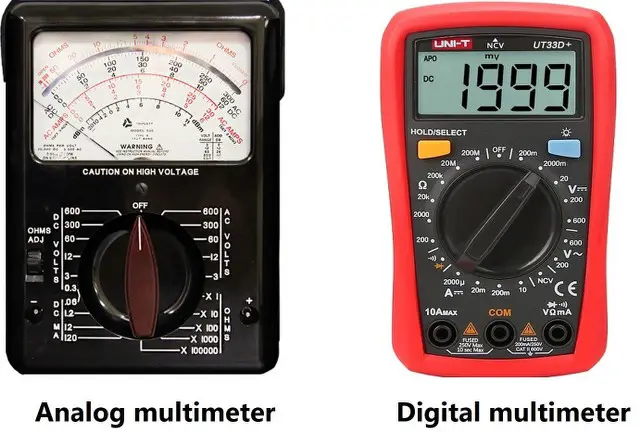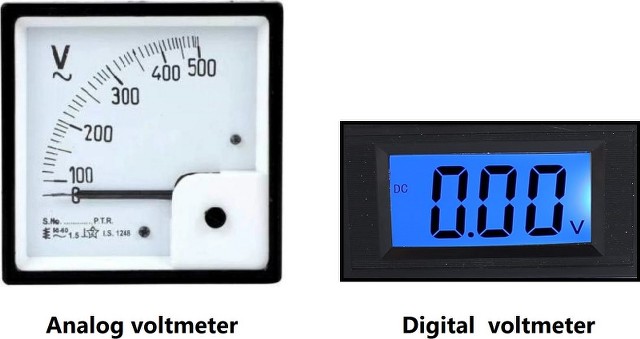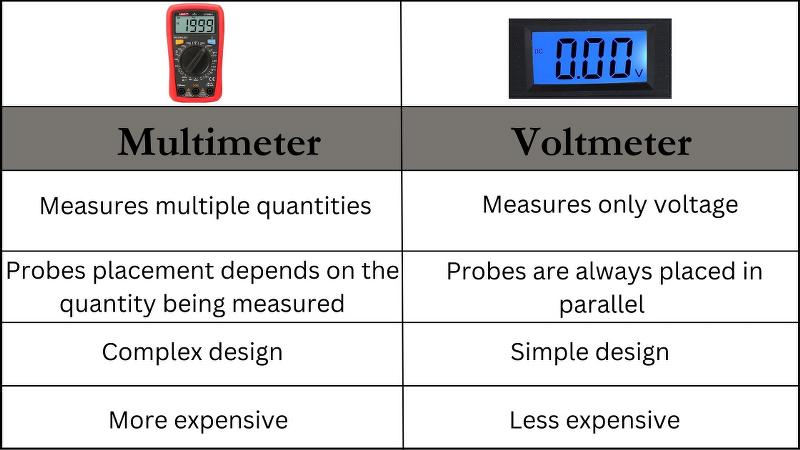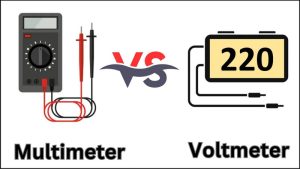A multimeter and a voltmeter are two important circuit diagnostic tools in electric and electronic circuits. Although they are interchangeable, they are distinct in numerous ways. Because they are similar in appearance, it is also possible to choose the incorrect device. Let us see how multimeters and voltmeters are similar and unique.
As the name implies, a multimeter measures multiple quantities, and a voltmeter measures only voltage. Hence, we can use a multimeter as a voltmeter, but the reverse is not possible. Since voltmeters are exclusively for voltage measurement, they cost less than multimeters.
Selecting among them might be a little confusing since they appear almost similar in design. But multimeters are slightly larger than voltmeters. We can see numerous quantities marked around the knob of a multimeter. But voltmeters are simpler in design as well as application. If the requirement is just measuring the voltage, the voltmeter is the best choice. Measuring multiple quantities at the same time strictly requires a multimeter.
Introduction to Multimeter and Voltmeter
A multimeter, short of ‘multiple meter’, is a device that can measure several electrical parameters, including voltage, current, resistance, capacitance, frequency, etc. It has a wide range of applications, from electronics to household electrical systems.

Multimeters are available in analog and digital variants. The analog multimeters are called Voltage-Ohms-Amperes (VOM). The digital voltmeters are called Digital Multimeter (DMM).
The invention of the multimeter happened in 1920 by Donald Macadie. It was first called an “Avometer”. The later version was the vacuum tube multimeter. Gradually, in 1950, multimeters got digital screens. Several other updates occurred for the multimeter in 1958, 1967, 1972, and 1975. The most modern multimeters were introduced in 2013.
Voltmeters are used to measure the potential difference between two points in a circuit. It displays the result in millivolts, volts, and kilovolts. To measure the potential, we connect the probes of the voltmeter parallel to the circuit connection. Hence, we need not break the circuit to get the results.

The earlier voltmeters had large structures and measured the voltage using interactions between current and magnetic field. The first voltmeter was invented by Edward Weston in 1888. E.B. Moullin created the vacuum tube voltmeter in 1922, and Andrew Kay invented the first digital voltmeter in 1954. The current voltmeters are made of semiconductors. Hence, the device became smaller in size and more accurate.
What are the differences between a multimeter and a voltmeter?
Since multimeters and voltmeters are similar in numerous aspects, it will be later useful to chart their differences. It is also necessary to choose the one most suitable for your application.

| Parameter | Multimeter | Voltmeter |
|---|---|---|
| Purpose | Measures voltage along with current, resistance, frequency, circuit continuity, etc. | Detects the potential difference (voltage) across two nodes of a circuit. |
| Working | The multimeter has two probes. Whether the probes are placed in series or parallel to the circuit depends on the quantity measured. | The two probes of a voltmeter are always placed parallel to the circuit to measure the corresponding voltage |
| Internal Resistance | The internal resistance of a multimeter changes depending on its mode of operation. | Has high internal resistance since it is used to measure voltage. |
| Design Complexity | Has a complex design since it is used to measure various quantities. | Voltmeter has a very simple design since it is used to measure only the voltage. |
| Type | Analog multimeter, and digital multimeter | Analog voltmeter and digital |
| Cost | Typically more expensive than voltmeters due to their broader range of capabilities. | Cheaper than multimeters since they are designed only to measure voltages. |
| Applications | Widely used for in-depth troubleshooting of circuits. It is a multipurpose device that acts as a voltmeter, ammeter, ohmeter, continuity tester, diode tester, and so on. | The one and only purpose of a voltmeter is to detect the voltage between two points in a circuit. |
What are the similarities between a multimeter and a voltmeter?
Multimeters and voltmeters are similar in several features.
- The most prominent is that they are used to measure voltage. Multimeters are used to measure other quantities along with the voltage, whereas voltmeters are exclusively used to measure the voltage.
- Hence, both the multimeter and the voltmeter are standard diagnostic tools used by electricians.
- Both devices have a similar design and have a digital display and connecting probes.
- Both of them have analog and digital versions.
- They are portable devices and, hence, easy to carry and use in various electrical testing situations.
- Both instruments provide a numerical readout to display the measured voltage.
- Both multimeters and voltmeters measure voltage at a wide range of voltage levels. We can adjust these ranges with respect to the required precision.
- Both instruments are designed with safety features, such as overload protection, to prevent damage to the device or the circuit being tested in case of excessive voltage.
- Most multimeters and voltmeters are powered by batteries, making them independent of external power sources.
Conclusion
Both multimeters and voltmeters are suitable to measure the voltage. But a voltmeter will be most appropriate for this since it gives more precise measurements of voltage. However, different measurements have to be taken at the same time, so multimeters are very useful. Multimerets are, in a way, an all-in-one device. Hence, we should select the device as per the requirements.
